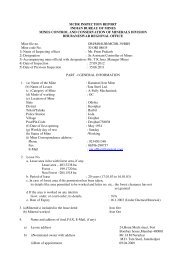Market Survey on Copper - Indian Bureau of Mines
Market Survey on Copper - Indian Bureau of Mines
Market Survey on Copper - Indian Bureau of Mines
You also want an ePaper? Increase the reach of your titles
YUMPU automatically turns print PDFs into web optimized ePapers that Google loves.
a) low capital and operating cost<br />
b) high SO2 c<strong>on</strong>centrati<strong>on</strong> (8 to 15%) in the effluent gas and<br />
c) high thermal efficiency and less air polluti<strong>on</strong>.<br />
About 375 to 425 kW/h electrical energy is required to smelt a t<strong>on</strong>ne <strong>of</strong><br />
calcined c<strong>on</strong>centrates. Efficient operati<strong>on</strong> <strong>of</strong> the furnace depends up<strong>on</strong> slag<br />
compositi<strong>on</strong> (35.5 - 38.5% SiO2) as heat generated for smelting is proporti<strong>on</strong>al<br />
to slag.<br />
vi) Flash Furnace Smelting : It is well-known that oxidati<strong>on</strong> <strong>of</strong> sulphide is<br />
an exothermic reacti<strong>on</strong>. Chalcopyrite oxidati<strong>on</strong> can be represented by the<br />
following equati<strong>on</strong>.<br />
2CuFeS2 + 2.5O2 +SiO2 (flux) � Cu2S. FeS + FeO.SiO2) + 2SO2 + heat<br />
(matte) (slag)<br />
It is this reacti<strong>on</strong> which provides much or all <strong>of</strong> the heat required for<br />
smelting (heating and melting) forms the basis for flash smelting. Additi<strong>on</strong>al<br />
hydrocarb<strong>on</strong> fuel is needed when air is the combustant. SO2 c<strong>on</strong>centrati<strong>on</strong> in<br />
the effluent gas is high (>10% SO2) and this can be pr<strong>of</strong>itably utilised for<br />
manufacture <strong>of</strong> H2SO4 and elemental sulphur. The major disadvantages <strong>of</strong> flash<br />
furnace smelting is higher copper losses in slag and fine dust necessitating<br />
additi<strong>on</strong>al treatment by flotati<strong>on</strong> or electric furnace smelting.<br />
vii) C<strong>on</strong>verting: Molten matte from smelting c<strong>on</strong>tains copper, ir<strong>on</strong>, sulphur<br />
as its predominant c<strong>on</strong>stituents with up to 3% dissolved oxygen. In additi<strong>on</strong>, it<br />
c<strong>on</strong>tains minor impurities (As, Sb, Bi, Ni, Pb, Zn, etc.) and precious metals.<br />
C<strong>on</strong>verting is removal <strong>of</strong> ir<strong>on</strong> and sulphur and other impurities from the<br />
matte by air oxidati<strong>on</strong> which results in producti<strong>on</strong> <strong>of</strong> liquid metallic copper in<br />
crude (98.5-99.5% Cu) blister copper form.<br />
Cu2S + 1.5O2 � Cu2O+SO2<br />
Cu2S+ 2Cu2O � 6Cu + SO2<br />
Cu2S+O2 � Cu + SO2<br />
viii) Slag Making<br />
FeS + O2 � Fe+ SO2<br />
3FeO + 0.5O2 � Fe2O4<br />
2FeO + 2SiO2 � 2FeO.SiO2<br />
i.e.<br />
Any Cu2O formed is re-sulphidised to Cu2S as per the following acti<strong>on</strong>,<br />
Cu2O + FeS � FeO + Cu2S<br />
39
















